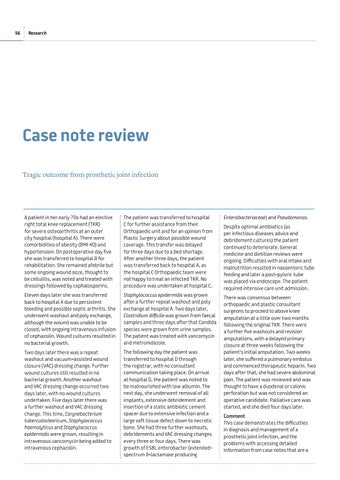56
Research
Case note review Tragic outcome from prosthetic joint infection
A patient in her early 70s had an elective right total knee replacement (TKR) for severe osteoarthritis at an outer city hospital (hospital A). There were comorbidities of obesity (BMI 40) and hypertension. On postoperative day five she was transferred to hospital B for rehabilitation. She remained afebrile but some ongoing wound ooze, thought to be cellulitis, was noted and treated with dressings followed by cephalosporins.
The patient was transferred to hospital C for further assistance from their Orthopaedic unit and for an opinion from Plastic Surgery about possible wound coverage. This transfer was delayed for three days due to a bed shortage. After another three days, the patient was transferred back to hospital A, as the hospital C Orthopaedic team were not happy to treat an infected TKR. No procedure was undertaken at hospital C.
Enterobacteriaceae) and Pseudomonas.
Eleven days later she was transferred back to hospital A due to persistent bleeding and possible septic arthritis. She underwent washout and poly exchange, although the wound was unable to be closed, with ongoing intravenous infusion of cephazolin. Wound cultures resulted in no bacterial growth.
Staphylococcus epidermidis was grown after a further repeat washout and poly exchange at hospital A. Two days later, Clostridium difficile was grown from faecal samples and three days after that Candida species were grown from urine samples. The patient was treated with vancomycin and metronidazole.
Two days later there was a repeat washout and vacuum-assisted wound closure (VAC) dressing change. Further wound cultures still resulted in no bacterial growth. Another washout and VAC dressing change occurred two days later, with no wound cultures undertaken. Five days later there was a further washout and VAC dressing change. This time, Corynebacterium tuberculostearicum, Staphylococcus haemolyticus and Staphylococcus epidermidis were grown, resulting in intravenous vancomycin being added to intravenous cephazolin.
The following day the patient was transferred to hospital D through the registrar, with no consultant communication taking place. On arrival at hospital D, the patient was noted to be malnourished with low albumin. The next day, she underwent removal of all implants, extensive debridement and insertion of a static antibiotic cement spacer due to extensive infection and a large soft tissue defect down to necrotic bone. She had three further washouts, debridements and VAC dressing changes every three or four days. There was growth of ESBL enterobacter (extendedspectrum ß-lactamase producing
There was consensus between orthopaedic and plastic consultant surgeons to proceed to above knee amputation at a little over two months following the original TKR. There were a further five washouts and revision amputations, with a delayed primary closure at three weeks following the patient’s initial amputation. Two weeks later, she suffered a pulmonary embolus and commenced therapeutic heparin. Two days after that, she had severe abdominal pain. The patient was reviewed and was thought to have a duodenal or colonic perforation but was not considered an operative candidate. Palliative care was started, and she died four days later.
Despite optimal antibiotics (as per infectious diseases advice and debridement cultures) the patient continued to deteriorate. General medicine and dietitian reviews were ongoing. Difficulties with oral intake and malnutrition resulted in nasoenteric tube feeding and later a post-pyloric tube was placed via endoscope. The patient required intensive care unit admission.
Comment This case demonstrates the difficulties in diagnosis and management of a prosthetic joint infection, and the problems with accessing detailed information from case notes that are a





























